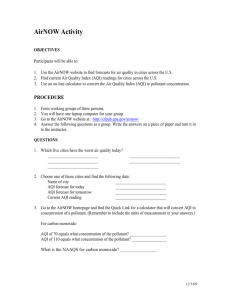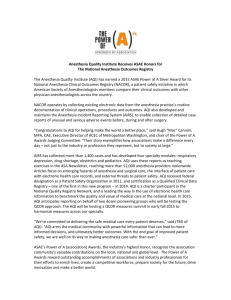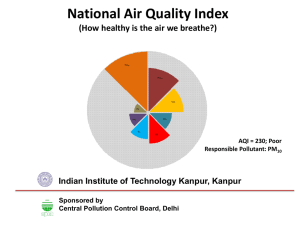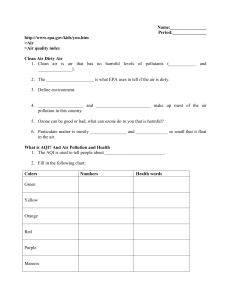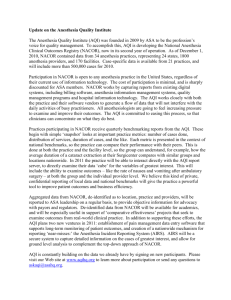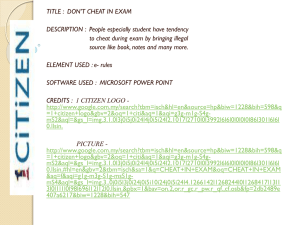EISD Action in Response to the Air Quality Health Alert
advertisement
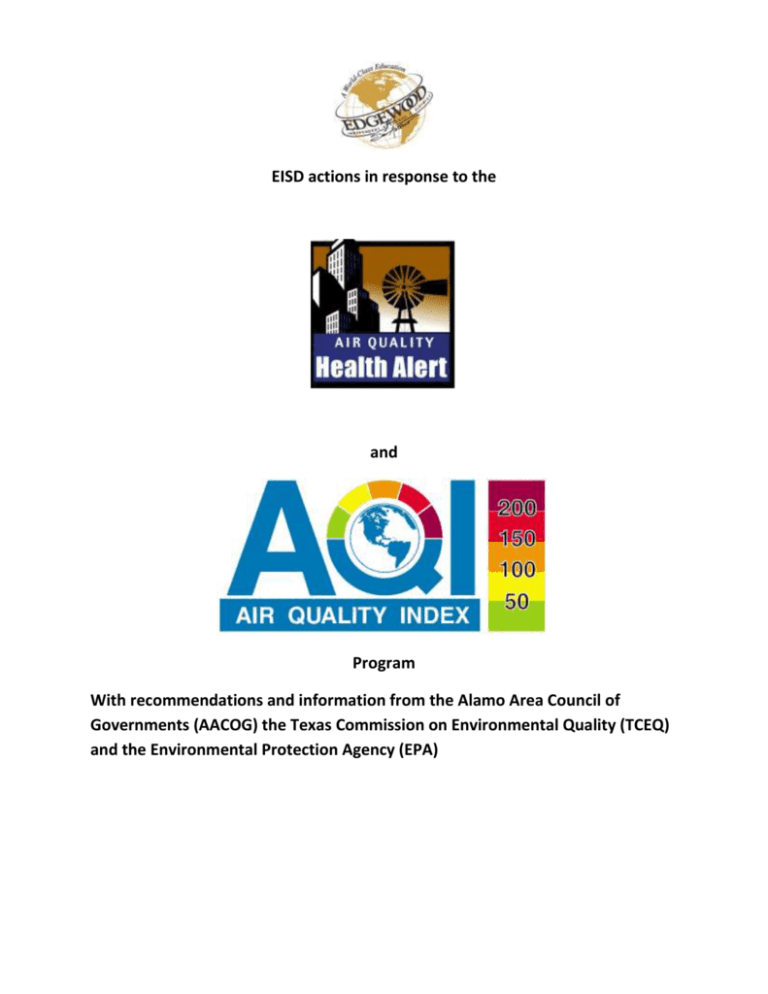
EISD actions in response to the and Program With recommendations and information from the Alamo Area Council of Governments (AACOG) the Texas Commission on Environmental Quality (TCEQ) and the Environmental Protection Agency (EPA) Air Quality Health Alert (AQHA) Program The Air Quality Health Alert (AQHA) notification program is a forecast of the potential that an air pollutant level in San Antonio will exceed the Environmental Protection Agency’s (EPA) Air Quality Index (AQI) Orange Target level sometime during the day. The air pollutant of concern in San Antonio is ground-level ozone. Outdoor air quality forecasts are made daily from April 1st to October 31st for the San Antonio area. Each forecast is a simple yes or no prediction for the question, “Will ozone near the ground reach or exceed a level at which it is considered unhealthy for sensitive groups (i.e., the Level Orange) in the San Antonio area?” If yes, an AQHA is announced the day before that level is expected so that persons living in the San Antonio area can take the following “preventative actions”: 1. to protect their health by limiting their exposure to the pollutant e.g. an Asthma Action Plan, and; 2. to reduce their pollution emissions so that the predicted target level is not actually achieved. See Appendix A for the list of AACOG recommended daily choices that can help reduce air pollution. Ozone pollution typically increases during hot days with little or no wind or when winds are coming from the northeast, east, and southeast direction. Area sampling and monitoring stations can show when the pollutant is exceeding an unhealthy level. Typically, high levels are experienced in the afternoon hours. Often the predicted level of pollution is not realized during the day due to changes in the local weather conditions that have prevented the accumulation of the pollutant. When AACOG receives a forecast of Level Orange ozone pollution (unhealthy for sensitive groups), it issues an AQHA to all local media entities and over 1,000 local organizations and individuals via email. AQHAs are announced with the weather during television network news, on most local radio stations, and in the San Antonio Express-News. Figure 1 is the official logo for the AACOG air quality health alert that is issued the day before ozone is predicted to reach unhealthy levels. Appendix A lists actions that AACOG recommends an individual to perform for preventing pollution. Figure 1 Logo of AACOG’s announcement for Air Quality Health Alert Day Air Quality Index (AQI) Program The Air Quality Index (AQI) is a rating system for each pollutant that establishes a relationship between the level of the pollutant and health effects that can be experienced by individuals exposed to that pollutant. Figure 2 shows the official logo for the EPA’s AQI program that appears on their website www.airnow.gov. Figure 2 Logo for the EPA’s Air Quality Index program Each of the six National Ambient Air Quality Standard (NAAQS) air pollutants has a separate AQI scale, with an AQI rating of 100 corresponding to the highest acceptable concentration for that pollutant. The AQI scale is divided into six categories and each pollutant will be color coded as shown in Figure 3: Figure 3 EPA’s Air Quality Index numerical and color codes for rating levels of outdoor pollutants AQI 0-50 51-100 101-150 151-200 201-300 301 + Air Quality Good Moderate Unhealthy for sensitive groups Unhealthy Very Unhealthy Hazardous Color The EPA lists daily national forecasts for selected cities in the United States. The AQI tells you how clean or polluted the air will be and warns of any associated health concerns. The AQI is being used across the nation by television, newspaper, websites (http://www.airnow.gov), and radio. Appendix B contains more details about the health effects of the common air pollutants. When the District receives notification of an Air Quality Health Alert and passes the information via E-Mail to each school campus, the campuses are to respond to an AQHA and AQI announcements as follows: Responses to Air Quality Health Alert announcement by ACCOG or other sources 1. Display the yellow Air Quality Health Alert banner as shown in Figure 4 that have been provided by AACOG in a prominent location so that persons can take the preventive actions recommended by their personal health physician and by AACOG; 2. Restrict outdoor activities for students in accordance to the student’s Asthma Action Plan, and the individual recommendations from their parents, guardian, or health physician. Figure 4 Air Quality Health Alert banner provided by AACOG to EISD schools Responses to Air Quality Index announcement from EISD Central Office 1. The EISD Central Office will forward an e-mail to each campus when an AQI level of Orange or Red for outside air pollution is actually being experienced in the San Antonio area, and; 2. Modify outdoor activities for students and staff when the EISD announcement is received that an Orange Level or Red Level for the AQI of an outdoor pollutant has been experienced in the San Antonio area. See the following restrictions for each category of student or campus. Restrictions Based on Actual San Antonio Area AQI Levels of Orange or Red Campus Administration Orange AQI Level: announce that all students identified by the campus nurse as having respiratory problems will remain indoors for recess and any other activities such as outdoor science labs and gardening projects. Field trips and field days should continue with campus approval. Field trips or field days that require the student to be outside for lengthy periods of time, could trigger respiratory and/or asthma problems in these students. The administration, nurse and teachers should be guided by the Asthma Action Plan to determine participation on an outdoor field trip. Medication will accompany each child during the field day or field trip and should be planned and documented by the campus nurse. Red AQI Level: there will be no outdoor activity for any student. Physical Education Orange AQI Levels, in schools with AIR CONDITIONED GYMS, students should remain inside the gym for activity. Orange AQI Levels, in schools with NON-AIR CONDITIONED GYMS, students with respiratory problems and/or asthma should not go to the gym. These students should go to another location for an alternate activity. The activity should be of low intensity to keep the students increased lung use at a minimum. The nurse should be contacted immediately, if a child experiences difficulty breathing. Red AQI Levels, in schools with AIR CONDITIONED GYMS, students should remain inside the gym for activity. The activity should be of low intensity to keep the students increased lung use at a minimum. Red AQI Levels, in schools with NON-AIR CONDITIONED GYMS, there will be no gym or outdoor activity for any student. Extracurricular Activity (e.g. ROTC, Band, Dance & Spirit Clubs) Orange AQI Levels, students with respiratory problems and/or asthma should not go outside. These students should stay indoors for an alternate activity. The activity should be of low intensity to keep the students increased lung use at a minimum. The nurse or health official should be contacted immediately if a child experiences difficulty breathing. Red AQI Levels, The Superintendent and or Program Director will decide what appropriate response will be implemented at the time of the activity or event. Restrictions Based on Actual San Antonio Area AQI Levels of Orange or Red Athletic Teams Orange AQI Levels, students that have a heart, respiratory and/or asthma condition will be placed in the “sensitive group”. Disclosure of “sensitive group” students will be the responsibility of parents and/or guardians, and must occur in grades 7-12 while enrolled in the athletic program. Students in the sensitive group must be cleared for outdoor activity by a physician during the athletic physical examination as required by the UIL for all students wishing to participate in athletics. Students in the sensitive group who fail to receive physician clearance will be subject to curtailed outdoor activity on Air Quality Alert Days. Additionally, parents and students of this group will be required to consult with the high school athletic trainer regarding preventive measures and district athletic procedures on Air Quality Alert Days Red AQI Levels, The Superintendent and or Athletic Director will decide what appropriate response will be implemented at the time of the activity or event. Classroom Teachers & Related Staff Orange AQI Levels, teachers and staff with respiratory problems and/or asthma should not go outside for prolonged periods.. Outdoor class assignments or experiments should be rescheduled for a non AQI Orange Level day. Red AQI Levels, there will be no outdoor activity for any teacher or staff. Notes: An Asthma Action Plan should be in place for each child who has asthma and requires school interventions or restrictions. A student’s family physician will be asked to complete an Asthma Action Plan. If the physician does not feel an asthma action plan is necessary, he/she should indicate that on the asthma action plan form and confirm that with his/her signature. The campus nurse is responsible for maintaining records and a list of all students who have respiratory health risks due to severe allergies, asthma, heart conditions or other issues. Campus nurses follow established protocols for record-keeping, parent communications, and medication management for students with these health risks. The campus nurse also provides a list of students at risk to teachers and other staff based on the need to know, and the nurse instructs staff as to precautions and interventions if risk situations are present. The current AQI scale and color codes are found at the AIRNOW webpage for the State of Texas http://www.airnow.gov/index.cfm?action=airnow.fcsummary Appendix A AACOG recommended daily choices to help reduce ozone air pollution: •Share a ride to work or school; •Avoid lunch-time trips–take your lunch to work or school; •Walk, ride a bicycle, car/vanpool, or ride the bus instead of driving alone; •Combine errands into one trip; •Avoid drive-through lanes; •Postpone refueling your vehicle and using gas-powered lawn equipment until after 6 p.m., and don't top off your gas tank; •Keep your vehicle properly tuned and your tires properly inflated for improved gas mileage; •Report smoking vehicles; •Participate in your local utility's energy conservation programs; and •Seal containers of household cleaners, workshop chemicals and solvents, and garden chemicals to prevent volatile organic compounds (VOC) from evaporating into the air. Appendix B August 2013
